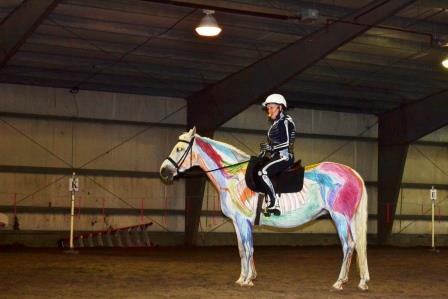
Home > Dispatches > Daily Dispatches 2017 >Daily Dispatch #135
May 15, 2017: Going Vertical, Part II
Yesterday’s dispatch was originally my post-clinic update for the Sally Swift Centered Riding scholarship. It was a small amount, but in my case, every little bit counts. I was required to come up with a write-up that may be included in the newsletter. I wrote about what I learned at the clinic about verticality. I most likely learned other things, but this is what came to mind. Yesterday, I went to the annual Parade of Stallions, a local event that used to be hosted by the Morgan horse club but is now hosted by another group – no one seems to know who – and watched the drill team and stallion owners strut their stuff. It was a cold, dreary day; Pete passed out clinic fliers. We drank hot chocolate to stay warm. |
 Peggy Brown during the Anatomy in Motion demo at the Saddle Up Arena |
|
|
What was most evident to me was that the horses appeared as though they were not having a good time at all. The majority of the riders were not vertical, and they were very heavy on the forehand. Some of the horses seemed to be fighting their every move. I wanted to jump out in the arena and begin to work with them. Last night I woke up and began obsessing about the Centered Riding building blocks of verticality. As is usually the case in such instances, I did not get as far in my thinking as I would have liked. I thought that I did, but I didn’t. Woke up disappointed. Writing is good because it’s here that I advance my ideas. Yesterday I wrote about one piece of the puzzle, which is verticality. The rider strives to become vertical in the hope that the horse will ultimately be more responsive under saddle, which is animated, responsive, and light in the hand. There is vertical movement upward and downward when the rider is doing a posting trot or cantering. And there is horizontal movement when the horse is (happily) moving forward. There is on the part of the rider (again) a vertical plumb line – it goes from the ear, to the shoulder, to the hips, to the ankle. There is also a horizontal plum line – it goes from mid-shoulder to center to hindquarters. The vertical and horizontal lines intersect at the horse’s center. This center is the origin of propulsion in the horse. Two circles of energy also correspond with the vertical and horizontal plumb lines. There is a vertical circle, which corresponds with the rider’s alignment, and a horizontal circle, which corresponds with the horse’s alignment. Balance comes about when the horse and rider are collectively in alignment. Less energy is expended, and the horse and rider then move together, with seemingly little effort. There. I made some progress. Now it will be interesting to see what my day’s ride on Raudi is like. We are heading over to Keith’s place to pick up the berries in our refrigerator. |
||